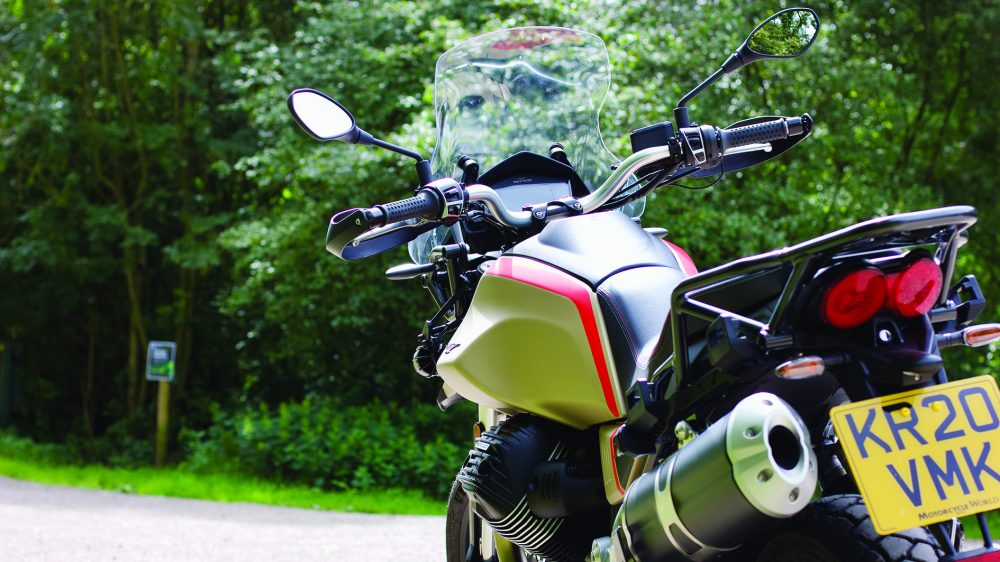
An absolute winner on paper; can the reality live up to my expectations?
Now here is a bike I’ve been waiting a very long time to ride. I never found time last year, and with the pandemic shuttering the country for months on end it’s taking some time to work through my shortlist of sensible do-it-all motorcycles. Can Moto-Guzzi’s retro-inspired entry into the increasingly-crowded market win me over?
On paper, things look pretty good. Technical specifications list a modest 80bhp from the modified 850cc version of Moto-Guzzi’s venerable ‘small-block’ twin pushing an acceptable 229kg wet weight. Part of this mass is accounted for by the class-leading 23 litre fuel capacity, a welcome sight in a world where BMW’s F900XR carries just 15 litres. ABS and traction-control are to be expected, full LED lighting is on-trend, but cruise control is still a welcome surprise. Four-piston Brembo front brakes bode well, and an air-cooled shaft-driven drivetrain is a fantastic recipe for a low-maintenance motorcycle.
Build quality is first class, even if aesthetics are highly subjective. I can appreciate the retro styling, but some colour schemes are definitely more appealing than others. There are fine details galore, including the Moto-Guzzi wings emblem designed right into the twin headlight housing as an LED running light. Paint is glossy and thick-looking but the number of exposed alloy surfaces suggest a salty winter might not be a good idea. Still, this is clearly a clean-sheet design – there are model-specific castings everywhere, and even the V9-derived engine is essentially all-new for this application.
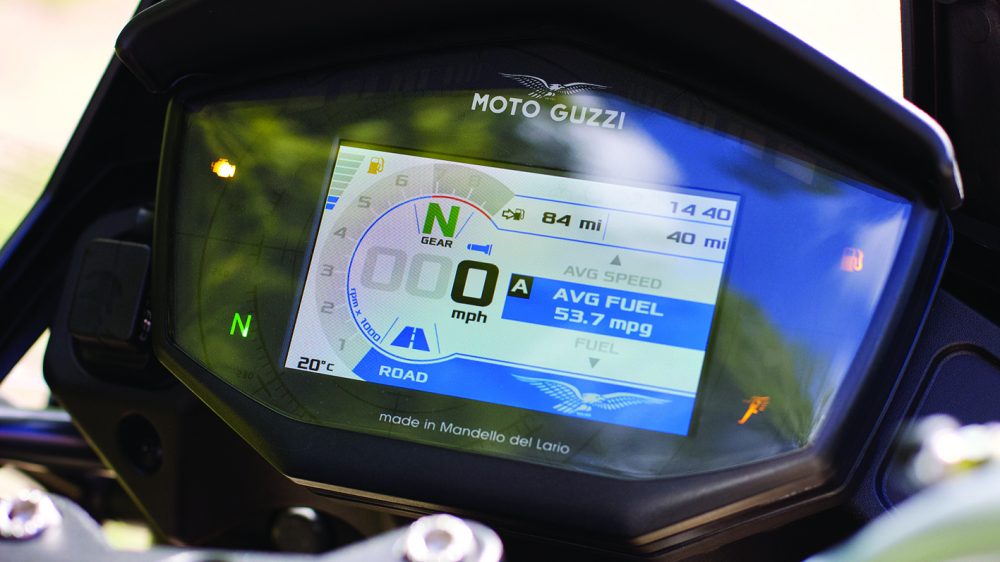
Colour dash is modern, but very much a first effort with clunky menus and tiny text.
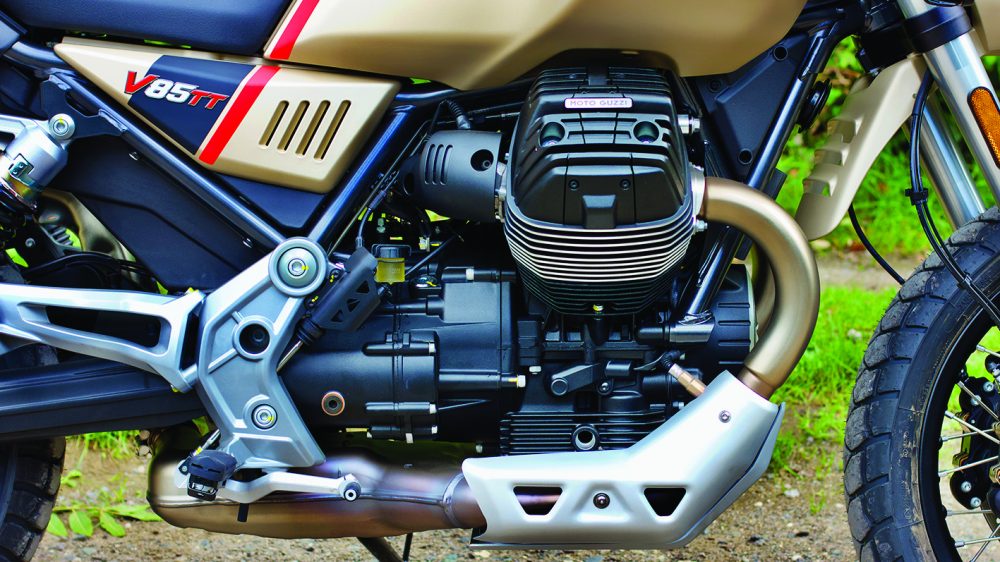
850cc 90-degree longitudinal twin has lost none of its character.
The rather small full-colour dashboard comes to life with a flashy animation, confirming that Moto-Guzzi are trying hard to be taken seriously in an increasingly high-tech market. But the noise and physical response that result from pressing (and holding) the starter button tell a very different story. The starter motor clunks, seethes, and whines, and the two cylinders cough and splutter into life after a second and settle into a loping, uneven idle. This is nothing like the refined experience recent BMW boxer twins have become; it’s far more akin to coaxing a Harley-Davidson to life.
That engine – and the sensations and motions it generates in the chassis even before you’ve selected first gear – set the tone for the entire riding experience of the V85TT. My words on that score should not necessarily be taken as criticism – I happen to love this sort of mechanical theatre. It gives each ride a sense of drama and occasion, but others may find the crudeness at odds with their expectations and quickly resent it.
Holding the bike upright in preparation for takeoff, the whole machine throbs beneath you, and blipping the throttle causes the chassis to twist to the right in reaction to the spinning crankshaft. Dropping into first is a little clunky, but once warmed up the gearbox is as slick as any I’ve used, to the point where clutchless shifting becomes easy and fun. Not that using the clutch is hard work – it’s feather-light, a modern affectation that hints at the modern engineering lurking beneath the old-school aesthetic. The ride-by-wire throttle is equally light, enabling the one-button cruise control and variable riding modes that, while having zero discernible effect, are de riguer for any new motorcycle in 2020.
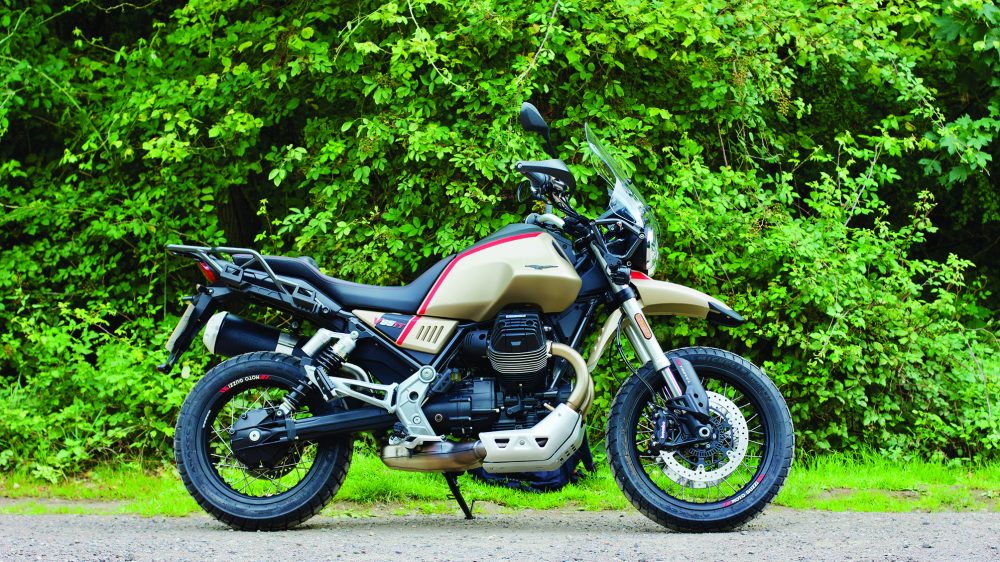
Once on the move, the mixed bag of new and old starts to become more problematic. The brakes work as well as you would expect from premium parts, and the suspension is on the good side of firm, but never quite settles. Turn-in is a little slow, possibly due to the extra weight of those spoked and tubed wheels. Still, the wide handlebars make it easy enough to lever the V85TT into corners, where it will happily hold or adjust a line without complaint. Trundling around town, the throttle seems a little imprecise, and there’s a definite feeling of stumbling from the engine, especially down low. I suspect that tuning an air-cooled engine to pass 2020 emissions regulations required some difficult compromises, and the ride-by-wire throttle is clearly being used to filter throttle inputs in compensation for the dips and bumps in the torque curve.
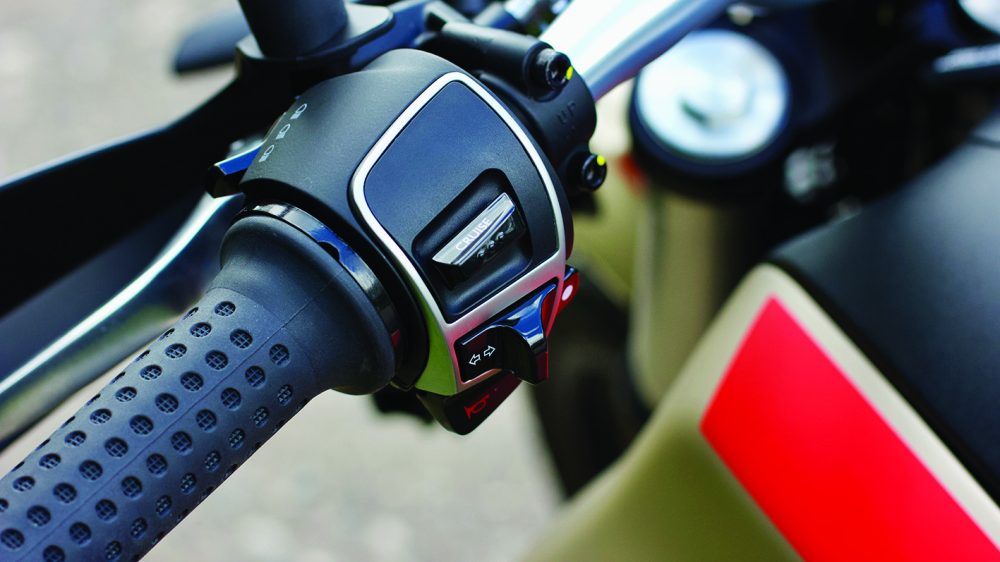
I like to think I’m a technical guy, but I couldn’t get the V85’s cruise control to work at all.
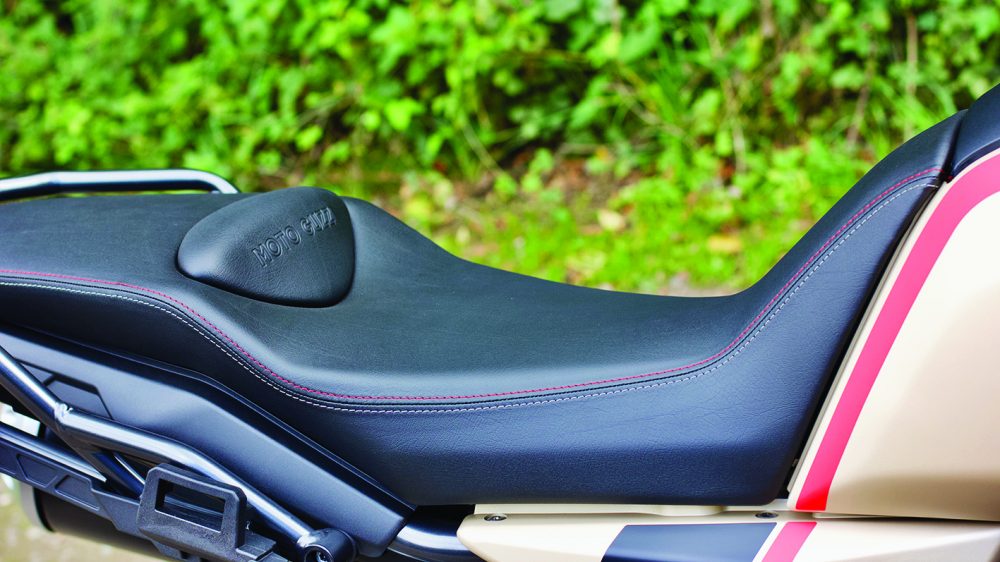
Beautiful to look at. Worst seat ever.
Outside of 30 mph speed limits some issues become magnified. The bike I rode was still being run in, with the engine speed limited by the computer to just 7,000RPM. Anything above 5,000 generated an increasingly distressing array of Christmas lights on the dashboard as the on-board computer implored me to take things easy with the new engine. As such, short-shifting was the order of the day, and while the 850cc 90-degree twin is willing enough low down, there isn’t enough power there for progressive overtakes, and not enough of a rev ceiling to go in search of all of the power plant’s claimed 80 horses. Once the unusually-long 1,000-mile running-in period was over and the full range of the engine could be used, things might be easier, but I can’t imagine the engine vibrating any less at higher revs. While this is one area where I was unable to make a fair assessment, I’m confident in saying that this is an engine that will always be happier on a relaxed trundle than a spirited ride.
And honestly, that could be said for the entire motorcycle. The firm yet unsettled suspension detracts from the enjoyment of the ride, giving a worryingly numb or detached feeling. Combined with the rather imprecise throttle, the V85TT comes across as somewhat bewildered at or above the national speed limit – more of an ivory-handled butter knife than a carbon-steel scalpel. But then you have to ask yourself – what would you rather have in your hand when buttering a scone during an unhurried afternoon tea?
Next, a new owner will need to do something about the worst seat I’ve ever encountered on a motorcycle. I can see what Moto-Guzzi were trying to do – it’s narrow near the front to facilitate a shorter reach to the ground, and wider further back for comfortable seating. But pushing yourself back that far creates an uncomfortable reach to the bars and prevents you from bracing your knees against the tank. I understand that shorter riders need to be accommodated, but those riders would also have even shorter arms, making this configuration a lose-lose for all parties. Moto-Guzzi offer an optional comfort seat, but I wouldn’t be enthusiastic about gambling on that solution with my own money.
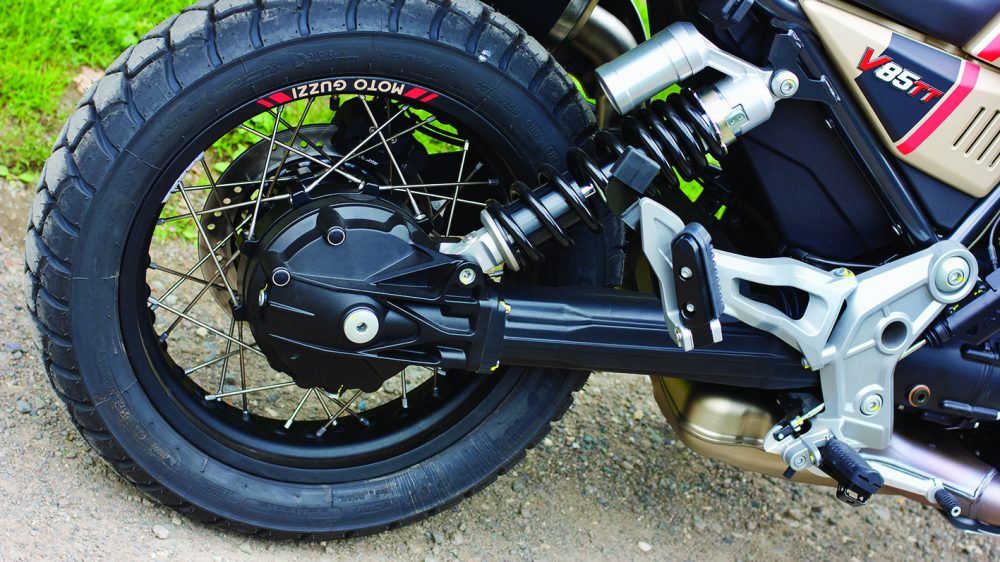
Every bike should have a shaft drive, in my opinon.

Mode switch seems to be entirely for show – the bike doesn’t feel any different regardless.
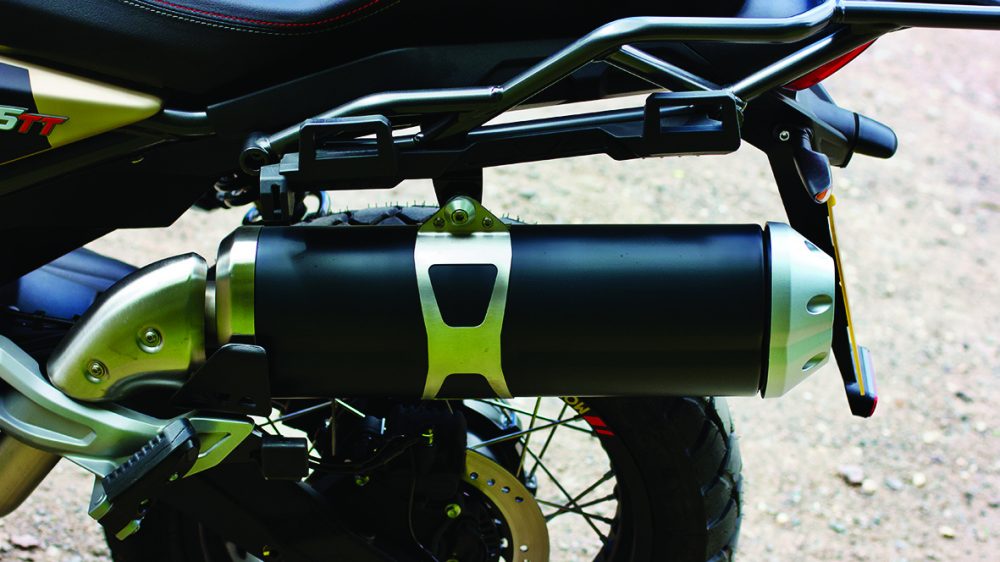
Exhaust looks bland and is mostly drowned out by the wind noise.
There are a few other small niggles. The indicator switch has no click when you press it, and very little travel, meaning that you’ll need to look down at the instrument panel to check if you’ve actually cancelled your signal. I couldn’t figure out how to activate the cruise control system, and it took two of us to deduce how to change engine modes, which, as I’ve mentioned above, seem to have zero actual effect. If you move your boots too far back or in and touch the frame you’ll discover the unpleasant buzzing vibrations that the rubber-faced pegs are hiding, so you have to be careful where you place your feet. And the tubed tyres mean that any punctures will require either tyre levers or a breakdown truck, rather than a 5-minute plug at the side of the road.
It’s a damn shame, as I’ve recently confirmed that the maintenance costs on Moto-Guzzis are hilariously low, thanks to those exposed cylinders and lack of coolant. Not only can mechanics get to the valves easily, adjusting them is the work of a moment due to their old-fashioned pushrod design. No chain to oil or adjust removes a tedious job at the end of a long day’s touring, and the oversized fuel capacity and impressive 55mpg should make for an excellent touring bike – and for some people I’m sure it will.
For my purposes, I need something a little sharper on a twisty road with fewer potential compromises to put down the £11,000 Moto-Guzzi want me to hand over in exchange for my own V85TT. It’s possible that I could fix the handling and comfort with suspension mods and a new seat, resolve the buffeting with an aftermarket screen and get used to the frustrating switchgear. Maybe I could convert the wheels to tubeless tyres, or replace them entirely with an aftermarket alternative. That done, I could perhaps enjoy the character and practical benefits of an air-cooled, shaft-driven Moto-Guzzi. But that’s a lot of ifs and maybes, a lot of financial risk I’d have to be comfortable with, and I’m not sure I’m willing to do that.
Nick Tasker
First published in Slipstream October 2020



